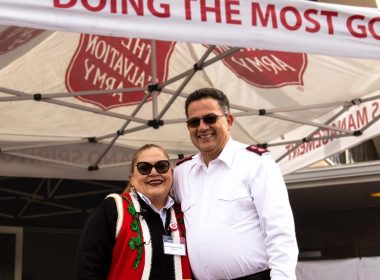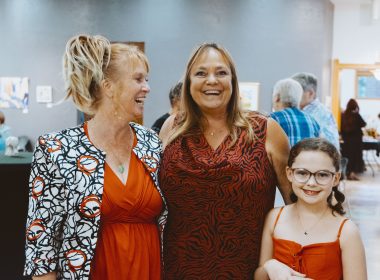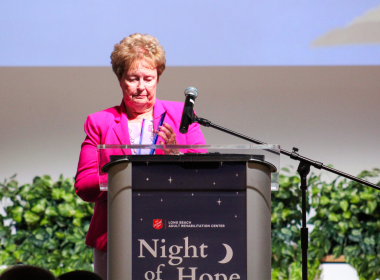Leave Thousands Destitute
by Cadet Amanda Reardon –
The northern California and western Nevada floods have ravaged thousands of square miles of territory as a half dozen rivers have swollen beyond their banks and burst through levees, creating billions of dollars in damages and leaving thousands destitute and inundated. The heroic response of the Army officers, soldiers, cadets and volunteers within both the Golden State and Del Oro divisions provided emergency housing, food and basic supplies, clothes, counseling and spiritual sustenance. As waters recede, the hard work continues, and the Army remains on the job.
As victims return home and examine the damage, the Army’s “Operation Noah’s Ark” goes into action. This is a long-term recovery program which the Army coordinates with other agencies in the various communities. Cleanup crews from all over the country are reporting to flood damaged areas. This effort will be followed by repair crews. Volunteers are needed for both phases.
For now, “Operation Noah’s Ark” involves taking large service vehicles into neighborhoods and parking them in central locations, accessible to anyone with a social service need. Food is being distributed, as are vouchers for clothing, furniture, appliances, prescriptions and personal items. After initial needs have been met, assessment teams from the flood relief centers will work with the Army to ascertain the particular needs of each community and develop a plan to meet those needs. Not only will cleaning supplies be brought door-to-door, but teams of volunteers will actually assist in the cleaning process. Eventually, damages and financial needs will be assessed, and counseling and spiritual support will be offered. Teams will also help recovering families tap into resources such as FEMA and HOME funds. Many families will not be living in their homes while they are working to restore them. Before their return, the Army will provide such final touches as draperies, bedding, towels, etc. A basket of “goodies” that includes a Bible will welcome families home.
The Army has done everything from sheltering displaced families to feeding lost pets. A number of shelters were run in conjunction with the Red Cross. In the Del Oro Division alone, 291,000 meals were served from 17 shelters and nine canteens. It is estimated that 80,000 flood victims were assisted by the Army in that division. Other statistics include 377 shelter nights in Modesto, Golden State Division, with 23,750 meals served, 2400 cleanup kits distributed, eight homes cleaned by Army volunteers, and 916 families given casework assistance. Meals were also served and food supplied in parts of Idaho, Washington, Nevada, and Oregon. Unaffected divisions throughout the territory have collected and sent supplies for relief work. Corporations such as WalMart, Thrifty/Payless, Home Depot and Sam’s Club have been helpful in this endeavor.
Captain Art Storey, territorial emergency services director, stated that the Del Oro Division, Golden State Division, and Adult Rehabilitation Center Command all worked together from one temporary command station within the Del Oro DHQ. Corps in both these divisions as well as six Adult Rehabilitation Centers lay within the area of heaviest damage throughout the valleys. According to Storey, officers from surrounding corps rushed to help corps within affected areas without waiting to be asked. “The attitude and cooperation among the officers was exciting to see.”
The true heroes, Storey reported, were local corps officers, soldiers and volunteers. “The local corps make it happen. They’re the backbone of the whole thing,” Storey said. He also expressed gratitude for the retired officers who covered regular corps activities for corps officers who were otherwise occupied. “You can’t imagine what a relief it was to the corps officers to have these people step in,” Storey said. These retirees included Majors Dan and Ruth Birks (R), Lt. Colonels Art and Alice Smith (R), Majors Elmer and Betty Yardley (R), Majors Richard and Evelyn Smith (R), and Majors Ken and Dorothy Osborne (R).
In Modesto, Calif., Captains Joe and Shawn Posillico, corps officers at Modesto Citadel, and Lieutenants Richard and Tammy Larson, corps officers at Modesto Red Shield, worked around the clock to provide immediate relief to flood victims. The Red Shield was opened as a shelter, and canteens brought all types of relief to victims and workers throughout the city. A local sewage plant sustained damage which resulted in contamination being carried by flood waters into all flooded areas. As a response, The Salvation Army joined together with the Stanislaus County Head Start program for the purpose of administering tetanus shots. This effort began when a Salvation Army volunteer cut his hand badly while assisting an elderly woman in tearing out the carpet in her home; the threat of disease due to contamination then became an issue. Larson spoke of a woman who both sought shelter and volunteered at the Red Shield. After a few days, she was permitted by authorities to go home, only to be stopped by her landlord who told her it would be six months before she could return home–her carpet, flooring and dry wall must all be ripped out and her furniture burned as a result of sewage contamination.
Lt. Danial Williams, corps officer at San Rafael, reported that in the Marysville/Yuba City area “everyone was affected in one way or another,” whether their homes were flooded or they were inconvenienced by loss of power. Local relief groups and churches looked to the Army for leadership in relief efforts. For many of the people whom the Army assisted in sheltering and feeding, “the water line on their homes was the ceiling,” said Williams. He gave an account of a dairy farmer who owned 250 cows–until 175 of them were drowned in the floods. “A dairy cow can’t just be bought,” said Williams, who was raised in the area. “A farmer has to get them as calves and train them. This man has lost his livelihood.” Many other dairy farmers and cattle ranchers have suffered the same consequence in this rural region.
In nearby Wheatland, the Army supplied food at several shelters. In one day, 13,860 meals were served from the shelter at Wheatland High School. In one instance, 600 evacuees turned up at the end of the day, cold and hungry. Volunteers were only able to find three cases of frozen chicken patties. Williams reminded the volunteers what Jesus had done with a few loaves and fishes; they prayed, and returned to the freezer to miraculously uncover enough cases of chicken to feed everyone.
In Stockton, more than 9,000 people were served meals. This included many hot meals fed to crews who were repairing levees. Lt. Gaylene Yardley, Stockton corps officer, understands the plight of flood victims: her own home was destroyed by floods when she was a teenager. “It’s like a part of your body is gone,” Yardley explained. Yardley faced the task at hand with both haunting personal memories and the handicap of having her husband sick with pneumonia. Two consecutive teams of cadets were sent to assist her. Cadet Daniel Freeman observed that “Many of the workers are out there for more than 12 hours a day doing the back-breaking work of filling sandbags. It was fulfilling to know that we could make a difference just by giving them some warm food.” Other cadets were sent to assist in Modesto and Marysville.
Divisional Commander Major Charles Strickland had words of praise for Army workers. “Our field officers, employees and volunteers have been tireless.” He added, “We’re grateful to God for his protection and providing of personnel and resources through our many friends and Salvationists in the Western Territory. Please continue to remember us in your prayers.”
Though California has dominated the headlines, other states have suffered under oppressive weather. In Reno and Carson City, Nev., the Army housed and fed hundreds from its facilities and mobile feeding units, as reported by Reno Commanding Officer Lt. Steve Arnold. In Idaho, Captain Tom Peterson, Boise commanding officer, assisted some 200 flooded families with food, clothing, and space heaters. In Renton, Wash., the Army prepared meals for shelters and took food and blankets to residents who were without power in Enumclaw and Arburn. In Bellingham, the Army fed search and rescue workers and those who were repairing a broken dam. In Centralia, the Army distributed meals and blankets to workers and victims, and fed police officers and the King 5 TV News crew.
According to Storey, three new government policies are placing more responsibility on the shoulders of non-profit relief groups such as the Army. The 1997 floods are the first large-scale disaster in the Western Territory in which these changes are an issue. First, California must now come up with 25 percent of the governmental relief funds, while 75 percent of the funds will be federal. If the state cannot meet its requirement, the federal government will not pay its portion, either. (In the Northridge earthquake of 1994, the state of California was only required to contribute 10 percent.) With California’s disaster zone approaching $2 billion in damages, the state government must produce $500 million. Second, anyone who lived in a flood plain area but failed to get flood insurance–which is costly–is not eligible for FEMA assistance. Third, the Welfare Reform Act that went into effect on January 1 prevents anyone who cannot produce proof of citizenship from getting assistance. All of these changes mean that fewer people will get relief through governmental channels, and will rely that much more on charities to help them put their lives back together.
One area of need the government does not address is the spiritual. For this, a Salvationist’s resources are endless. Throughout the territory, Salvationists have been praying with weather victims, and even leading souls to Christ. According to Captain Joe Posillico, a group of neighbors in a Modesto community gathered, with The Salvation Army as catalyst, to pray with a man whose most precious possession had been destroyed by mud: a box full of memoirs of his wife. His wife had died three years earlier, and the box contained every physical memory of her.
Cadet Ken Perine gave witness when crew members working on a levee in Stockton asked what motivated him to provide assistance. “We don’t just do this because we’re nice people,” he said. “We do this because we have the love of Christ in us.”











